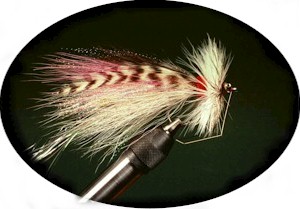Betty,
For your applications, they probably won’t do anything for you. That being said, a jig hook is just a plain hook with a different ‘shape’, something that’s more common in traditional ‘fly’ tying than anywhere else in angling.
Where this would ‘help’ folks is places where you are fishing a weighted nymph and having bottom hanging problems…the upward riding hook would reduce the hang ups.
Whatfly,
In my albeit unscientific ‘tests’ of the hook ‘style’ (I don’t mold lead on them, it’s way too much trouble to do tiny heads like that with a gravity feed mold) I’ve found that even an otherwise unweighted tie still rides with the hook upright as long as it’s tied to a line that comes from above the fly (if you use a heavy split shot ahead of the fly, one that runs lower in the water column than the fly, it can flip the fly over if the materials are bouyant).
If you add ANY weight, either weight ‘wrapped’ on the shank or a bead slid onto the hook, the hook rides upright always.
A few other things I’ve been figuring out while playing with these hooks:
After watching drifts with weighted nymphs on both the regular TDE hooks I used to use, and the ‘jig’ bend hooks, the fly does seem to ride if not more ‘naturally’ (I’m not sure if ‘horozontal with a slight nose up attitude’ is ‘natural’) certainly more consistently in the water. Whether that is good or bad I’ll have to let the fish tell me this summer.
If you find that your wooly buggers are ‘twisting’ on you, these hook will alleviate that problem quite a bit.
Where this hook style shines, though, is on stuff fished in still water under an indicator. I’ve caught trout, smallies, pike, bluegills, and crappie on this ‘style’ of rig in several states.
I’m also noticing a better ‘hook up’ ratio on light biting fish. Maybe I’m just getting better at ‘hooking’ them, but I was catching more fish using these hooks last summer than I did the year before without them. Maybe it’s the hook attitude, or the angle of pull changed caused by the turned down eye. Don’t know why, but I do like the results so far.
And, for you guys who are ‘buying’ the small ‘lead head fly tying jigs’ they sell, I maybe can save you some coin here.
Most of these hooks are centrifically molded with just a tiny amount of lead. 1/64 to 1/120 ounce. They are ‘pricey’, at least to me, at around $2.50 to $5.00 a dozen depending if you want a ‘finished’ head or plain lead.
You can get basically the ‘same thing’ by simply sliding a regular fly tying bead onto the hook. The materials hold it in place. You can get them in several finishes as well as sizes. Much cheaper and it works the same (nickle for the hook, seven to ten cents for the bead, runs around 1/2 the price per).
Not for everyone, certainly. But they do seem to work well for me so far. I’m having fun playing with expanding the concept.
Buddy


